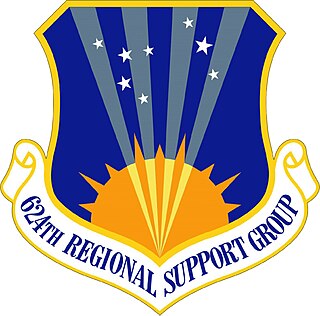
The Nineteenth Air Force is an active Numbered Air Force of the United States Air Force. During the Cold War it was a component of Tactical Air Command, with a mission of command and control over deployed USAF forces in support of United States foreign policy initiatives. The command was reactivated in 1993 under Air Education and Training Command with a mission of conducting AETC's flying training.

The Military Airlift Command (MAC) is an inactive United States Air Force major command (MAJCOM) that was headquartered at Scott Air Force Base, Illinois. Established on 1 January 1966, MAC was the primary strategic airlift organization of the Air Force until 1974, when Air Force tactical airlift units in the Tactical Air Command (TAC) were merged into MAC to create a unified airlift organization.

Rapid Engineer Deployable Heavy Operational Repair Squadron Engineer squadrons are the United States Air Force's heavy-construction units. Their combat engineering capabilities are similar to those of the U.S. Navy Seabees and U.S. Army heavy-construction organizations.

Bien Hoa Air Base is a Vietnam People's Air Force (VPAF) military airfield located in South-Central southern Vietnam about 25 km (16 mi) from Ho Chi Minh City, across the Dong Nai river in the northern ward of Tân Phong, and within the city of Biên Hòa within Đồng Nai Province. The boomburb city is densely populated and rings the base, despite significant levels of agent orange toxins simply left there for decades. The base is scheduled to begin cleanup by 2019.

Phan Rang Air Base is a Vietnam People's Air Force (VPAF) (Khong Quan Nhan Dan Viet Nam) military airfield in Vietnam. It is located 5.2 miles north-northwest of Phan Rang – Tháp Chàm in Ninh Thuận Province.

Tan Son Nhut Air Base (1955–1975) was a Republic of Vietnam Air Force (RVNAF) facility. It was located near the city of Saigon in southern Vietnam. The United States used it as a major base during the Vietnam War (1959–1975), stationing Army, Air Force, Navy, and Marine units there. Following the Fall of Saigon, it was taken over as a Vietnam People's Air Force (VPAF) facility and remains in use today.

The 2nd Air Division is an inactive United States Air Force organization. Its last assignment was with Military Airlift Command, assigned to Twenty-Third Air Force, being stationed at Hurlburt Field, Florida. It started operations on 7 November 1942 as 2nd Bomb Wing and was reorganized as the 2nd Bomb Division on 13 September 1943 before its final designation as the 2nd Air Division in January 1945. It was last inactivated on 1 February 1987.

The 354th Fighter Wing is a United States Air Force wing that is part of Pacific Air Forces (PACAF). It is the host wing at Eielson Air Force Base, Alaska, and is assigned to the Eleventh Air Force.

The 621st Contingency Response Wing is a United States Air Force rapid response expeditionary wing, based out of the McGuire Air Force Base entity of Joint Base McGuire-Dix-Lakehurst, New Jersey and Travis Air Force Base, California highly-specialized in training and rapidly deploying personnel globally to quickly open airfields and establish, expand, sustain, and coordinate air mobility operations during a variety of contingency operations.
The Delaware Air National Guard (DE ANG) is the aerial militia of the State of Delaware, United States of America. It is, along with the Delaware Army National Guard, an element of the Delaware National Guard.

The Warner Robins Air Logistics Complex (WR-ALC), through about 7,000 employees at Robins Air Force Base, Georgia, provides depot maintenance, engineering support and software development to major weapon systems [F-15, C-5, C-130, C-17 and Special Operations Forces (SOF) aircraft]. The Complex achieves command objectives providing a capability/capacity to support peacetime maintenance requirements, wartime emergency demands, aircraft battle damage repair and a ready source of maintenance of critical items.

The 624th Regional Support Group(RSG), headquartered at Hickam Air Force Base, Hawaii, is one of two Air Force Reserve groups stationed in the Pacific Area of Responsibility and reports directly to the headquarters of the 4th Air Force at March Air Reserve Base, California.
The United States Air Force's 202d RED HORSE squadron is a civil engineering unit of the Florida Air National Guard located at Camp Blanding, Florida. The acronym RED HORSE is derived from "Rapid Engineer Deployable Heavy Operational Repair Squadron Engineers" and are a key element of the capabilities of the broader USAF civil engineering community. If mobilized to active duty with the U.S. Air Force, the squadron is operationally-gained by the Air Combat Command (ACC).

The Bombing of Tan Son Nhut Air Base occurred on April 28, 1975, just two days before the Fall of Saigon. The bombing operation was carried out by the Vietnam People's Air Force (VPAF) Quyet Thang Squadron, using captured Republic of Vietnam Air Force (RVNAF) A-37 Dragonfly aircraft flown by VPAF pilots and RVNAF defectors led by Nguyen Thanh Trung who had bombed the Presidential Palace in Saigon on 8 April 1975.

The 819th RED HORSE Squadron is a unit of civil engineers based at Malmstrom Air Force Base, Montana, who are responsible for heavy duty repairs around the world. Originally activated at Dyess Air Force Base, Texas, the unit has been active and inactive at several different bases over the last 55 years. The unit was most recently activated as the first ever Air Force-Air National Guard RED HORSE associate unit at Malmstrom on 1 June 1997. The unit is ready at all times to fully deploy to anywhere in the world and remain stationed for an indefinite amount of time. The squadron's most notable deployment was in Vietnam, where it received numerous awards for its work during the war.

The 92nd Engineer Battalion is a unit of the United States Army with a record of accomplishment in both peace and war; an organization that provides sustained engineer support across the full spectrum of military operations.

A Viet Cong (VC) attack on Tan Son Nhut Air Base occurred during the early hours of 4 December 1966, during the Vietnam War. Tan Son Nhut Air Base was one of the major air bases used for offensive air operations within South Vietnam and for the support of United States Army and Army of the Republic of Vietnam (ARVN) ground operations. The attack by VC sappers, supported by mortar fire, was repulsed by the United States Air Force (USAF) base security forces by 04:00, though VC stragglers continued to be engaged in and around the base until 5 December.

The Kingdom of Thailand, under the administration of military dictator Field Marshal Thanom Kittikachorn, took an active role in the Vietnam War. Thailand was the third-largest provider of ground forces to South Vietnam, following the Americans and South Koreans.

Robins Air Force Base is a major United States Air Force installation located in Houston County, Georgia, United States. The base is located just east of the city of Warner Robins, 18 mi (29 km) south-southeast of Macon and approximately 100 mi (160 km) south-southeast of Atlanta, Georgia. The base is named in honor of Brig Gen Augustine Warner Robins, the Air Force's "father of logistics". The base is the single largest industrial complex in Georgia, employing a workforce of over 25,584 civilian, contractor, and military members.















